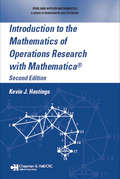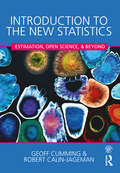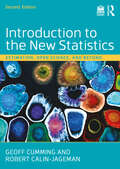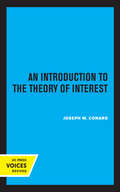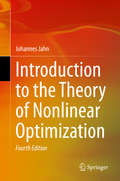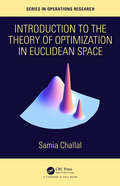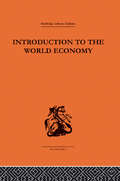- Table View
- List View
Introduction to the Law and Legal System of the United States (Second Edition)
by William BurnhamGovernmental structure, history, the adversary system, jury trials, the legal profession, the judicial system, administrative law, civil procedures, criminal procedures, constitutional law, contracts and commercial law, torts, property law, family law, criminal law, business law, and tax law.
Introduction to the Law of Property, Estate Planning, and Insurance
by Jethro K. Lieberman Don Mayer Daniel M. Warner George J. SiedelMayer, Warner, Siedel and Lieberman's Introduction to the Law of Property, Estate Planning and Insurance is an up-to-date textbook that covers legal issues that students must understand relating to real estate (an especially important business asset), as well as estate planning and insurance. The text is organized to permit instructors to tailor the materials to their particular approach. The authors take special care to engage students by relating law to everyday events with their clear, concise and readable style. After introductory chapters covering the legal environment of business, Introduction to the Law of Property, Estate Planning and Insurance provides students with context and essential legal concepts relating to property rights and duties, estate planning, insurance, secured transactions, mortgages, and related topics. The text provides the vocabulary and legal savvy they will need when working with these concepts, which are critical to business planning and success. With Introduction to the Law of Property, Estate Planning and Insurance, the authors have created a text that not only has both case summaries and excerpted cases, but one that you can easily customize by deleting chapters, reordering the content, adding your own material, and even editing at the line level with Flat World's easy-to-use MIYO (Make It Your Own) Platform. The free online version of the text includes embedded links to law-related videos at YouTube and other online sites for easy access by students and instructors.
Introduction to the Management Control Process
by David F. HawkinsCovers the management control process.
Introduction to the Mathematics of Operations Research with Mathematica®
by Kevin J. HastingsThe breadth of information about operations research and the overwhelming size of previous sources on the subject make it a difficult topic for non-specialists to grasp. Fortunately, Introduction to the Mathematics of Operations Research with Mathematica®, Second Edition delivers a concise analysis that benefits professionals in operations research and related fields in statistics, management, applied mathematics, and finance.The second edition retains the character of the earlier version, while incorporating developments in the sphere of operations research, technology, and mathematics pedagogy. Covering the topics crucial to applied mathematics, it examines graph theory, linear programming, stochastic processes, and dynamic programming. This self-contained text includes an accompanying electronic version and a package of useful commands. The electronic version is in the form of Mathematica notebooks, enabling you to devise, edit, and execute/reexecute commands, increasing your level of comprehension and problem-solving.Mathematica sharpens the impact of this book by allowing you to conveniently carry out graph algorithms, experiment with large powers of adjacency matrices in order to check the path counting theorem and Markov chains, construct feasible regions of linear programming problems, and use the "dictionary" method to solve these problems. You can also create simulators for Markov chains, Poisson processes, and Brownian motions in Mathematica, increasing your understanding of the defining conditions of these processes. Among many other benefits, Mathematica also promotes recursive solutions for problems related to first passage times and absorption probabilities.
Introduction to the New Statistics: Estimation, Open Science, and Beyond
by Geoff Cumming Robert Calin-JagemanThis is the first introductory statistics text to use an estimation approach from the start to help readers understand effect sizes, confidence intervals (CIs), and meta-analysis (‘the new statistics’). It is also the first text to explain the new and exciting Open Science practices, which encourage replication and enhance the trustworthiness of research. In addition, the book explains NHST fully so students can understand published research. Numerous real research examples are used throughout. The book uses today’s most effective learning strategies and promotes critical thinking, comprehension, and retention, to deepen users’ understanding of statistics and modern research methods. The free ESCI (Exploratory Software for Confidence Intervals) software makes concepts visually vivid, and provides calculation and graphing facilities. The book can be used with or without ESCI. Other highlights include: - Coverage of both estimation and NHST approaches, and how to easily translate between the two. - Some exercises use ESCI to analyze data and create graphs including CIs, for best understanding of estimation methods. -Videos of the authors describing key concepts and demonstrating use of ESCI provide an engaging learning tool for traditional or flipped classrooms. -In-chapter exercises and quizzes with related commentary allow students to learn by doing, and to monitor their progress. -End-of-chapter exercises and commentary, many using real data, give practice for using the new statistics to analyze data, as well as for applying research judgment in realistic contexts. -Don’t fool yourself tips help students avoid common errors. -Red Flags highlight the meaning of "significance" and what p values actually mean. -Chapter outlines, defined key terms, sidebars of key points, and summarized take-home messages provide a study tool at exam time. -http://www.routledge.com/cw/cumming offers for students: ESCI downloads; data sets; key term flashcards; tips for using SPSS for analyzing data; and videos. For instructors it offers: tips for teaching the new statistics and Open Science; additional homework exercises; assessment items; answer keys for homework and assessment items; and downloadable text images; and PowerPoint lecture slides. Intended for introduction to statistics, data analysis, or quantitative methods courses in psychology, education, and other social and health sciences, researchers interested in understanding the new statistics will also appreciate this book. No familiarity with introductory statistics is assumed.
Introduction to the New Statistics: Estimation, Open Science, and Beyond
by Geoff Cumming Robert Calin-JagemanThis fully revised and updated second edition is an essential introduction to inferential statistics. It is the first introductory statistics text to use an estimation approach from the start and also to explain the new and exciting Open Science practices, which encourage replication and enhance the trustworthiness of research. The estimation approach, with meta-analysis (“the new statistics”), is exactly what’s needed for Open Science.Key features of this new edition include: Even greater prominence for Open Science throughout the book. Students easily understand basic Open Science practices and are guided to use them in their own work. There is discussion of the latest developments now being widely adopted across science and medicine. Integration of new open-source esci (Estimation Statistics with Confidence Intervals) software, running in jamovi. This is ideal for the book and extends seamlessly to what’s required for more advanced courses, and also by researchers. See www.thenewstatistics.com/itns/esci/jesci/. Colorful interactive simulations, including the famous dances, to help make key statistical ideas intuitive. These are now freely available through any browser. See www.esci.thenewstatistics.com/. Coverage of both estimation and null hypothesis significance testing (NHST) approaches, with full guidance on how to translate between the two. Effective learning strategies and pedagogical features to promote critical thinking, comprehension and retention Designed for introduction to statistics, data analysis, or quantitative methods courses in psychology, education, and other social and health sciences, researchers interested in understanding Open Science and the new statistics will also appreciate this book. No familiarity with introductory statistics is assumed.A comprehensive website offers data sets, key term flashcards, learning guides, and videos describing key concepts and demonstrating the use of esci. For instructors, there are guides for teaching the new statistics and Open Science, assessment exercises, question banks, downloadable slides, and more. Altogether, the website provides engaging learning resources for traditional or flipped classrooms. See www.routledge.com/cw/cumming.
Introduction to the Theory of Interest (UCLA Publications of the Bureau of Business and Economic Research)
by Joseph W. ConardThis title is part of UC Press's Voices Revived program, which commemorates University of California Press’s mission to seek out and cultivate the brightest minds and give them voice, reach, and impact. Drawing on a backlist dating to 1893, Voices Revived makes high-quality, peer-reviewed scholarship accessible once again using print-on-demand technology. This title was originally published in 1959.
Introduction to the Theory of Nonlinear Optimization
by Johannes JahnThis book serves as an introductory text to optimization theory in normed spaces and covers all areas of nonlinear optimization. It presents fundamentals with particular emphasis on the application to problems in the calculus of variations, approximation and optimal control theory. The reader is expected to have a basic knowledge of linear functional analysis.
Introduction to the Theory of Optimization in Euclidean Space (Chapman & Hall/CRC Series in Operations Research)
by Samia ChallalIntroduction to the Theory of Optimization in Euclidean Space is intended to provide students with a robust introduction to optimization in Euclidean space, demonstrating the theoretical aspects of the subject whilst also providing clear proofs and applications. Students are taken progressively through the development of the proofs, where they have the occasion to practice tools of differentiation (Chain rule, Taylor formula) for functions of several variables in abstract situations. Throughout this book, students will learn the necessity of referring to important results established in advanced Algebra and Analysis courses. Features Rigorous and practical, offering proofs and applications of theorems Suitable as a textbook for advanced undergraduate students on mathematics or economics courses, or as reference for graduate-level readers Introduces complex principles in a clear, illustrative fashion
Introduction to the Transformation Pathways: Taking the Right Transformation Path
by Bart Victor Andrew C. BoyntonFirms that succeed in the long run create market value by continuously transforming their capabilities, and by making the transformation process part of the daily activities, decisions, and learning of managers and workers. This chapter introduces a series of four steps for transforming present capabilities into ones that will allow you to succeed in the future.
Introduction to the UK Hospitality Industry: A Comparative Approach
by Bob Brotherton'An Introduction to the UK Hospitality Industry: a comparative approach' is a core text for introductory hospitality modules and courses. Unique in its structure; this text looks at key aspects and compares them with each sector of the industry to give students a broader and comprehensive view of the topic. Key aspects of the industry are discussed, including the following areas:* Management practices* Work patterns and employment practices* Industry and financial structures* IT applications* Customers and marketsWritten in a user friendly style, the following features have been incorporated:* Chapter objectives* Case studies* Review questions* Chapter conclusions* Further reading and bibliography.Contributors to this text are amongst the most highly acclaimed in the hospitality field and bring with them a wealth of knowledge.
Introduction to the World Economy
by A J BrownWell constructed and thoroughly competent" - The Economist "It is refreshingly differentThe new-comer to economics who studies this book should find it an interesting and invigorating task" - Economic Journal This book introduces readers to some of the salient features and problems of the world economy and gives some indication of the main ways in which economists set about the task of analyzing them. After a general account of what economies are and how they work, the book's discussion develops with reference to broad statistical facts in relation to the following issues: why the world economy is as we find it; why productivity varies from one community to another; how prices are formed; how national economies have grown; what determines an economy's occupational structure; how local specialization comes about; how the pattern of international trade has grown and changed and what the main sources of insecurity in economic life are.
Introduction: Beyond Customer and Employee Satisfaction-The Ownership Quotient
by James L. Heskett Joe Wheeler W. Earl Sasser Jr.A customer owner is one who tries a product or service, is so satisfied that she returns to buy more, states a willingness to tell others of her experiences, actually convinces others to buy, provides constructive criticism of existing offerings, and even suggests or helps test new products or ideas. A customer who behaves like an owner is worth more than a hundred typical price-sensitive customers over the customer owner's lifetime with your organization. Similarly, the lifetime value of an employee who can promote customer ownership is priceless, and an organization that learns how to cultivate an ownership attitude creates a self-reinforcing relationship between customers and frontline employees. This chapter introduces the service profit chain, which will help you develop the preconditions for ownership in your organization, and describes how to measure the ownership quotient of your customers and employees.
Introduction: Data Are Business Assets--The Time is Now to Put Them to Work in Your Organization
by Thomas C. RedmanData and information have many properties that, collectively, present unparalleled opportunities and daunting challenges. Unfortunately, in today's organizations, data and information remain essentially unmanaged assets. Organizations must develop deep understanding of their eclectic properties, where they come from, how they move around, and the myriad ways in which they help create - and destroy - value.
Introduction: Embracing Psychological Impasse
by Timothy ButlerEven if you have the "perfect job," it is still possible to feel miserable and unfulfilled. The first step to fixing psychological impasse is realizing that you have a choice; you don't have to stay in a place that makes you unhappy. For those who choose to fully experience impasse life will prove more challenging and, at the same time, more authentic.
Introduction: Gen Y's in the Workplace
by Tamara EricksonChances are good that you, as a member of Generation Y, will not find today's workplace immediately well matched to your preferences and style. Much of that stems from generational gaps - the different ways that you and your Boomer or Gen X coworkers view the world. Your success will depend on understanding how other generations think and work, and how you can plug in to work effectively with them.
Introduction: Green Recovery--Why Going Green is the Key to Reviving Your Business
by Andrew WinstonAccording to Andrew Winston--expert on green business and coauthor of the best-selling book "Green to Gold"--greening your business is more important now than ever. While it may be hard to imagine focusing on sustainability in the midst of a recession, Winston argues that the smartest companies are recommitting to sustainability, and using environmental thinking not only to stay profitable, but also to drive innovation and help customers through these tough economic times. This introduction provides an overview of how greening your business can save you money quickly and help you build a stronger more resilient company--one ready to take the lead from slower-moving competitors. This chapter was originally published as the introduction to "Green Recovery: Get Lean, Get Smart, and Emerge from the Downturn On Top."
Introduction: How to Succeed When Professionals Drive Results
by Jay W. Lorsch Thomas J. TierneyOutstanding professional service firms are consistently able to identify, attract, and retain star performers. This chapter outlines some of the book's key concepts and introduces the central question of why some professional service firms succeed through the ups and downs of the business cycle while others fall behind.
Introduction: Innovation Tournaments Help to Identify Exceptional Opportunities
by Christian Terwiesch Karl T. UlrichIn the game of innovation, no bet comes with a guarantee--there will always be risk involved. But that doesn't mean you can't become a better player by shifting the odds in your favor. Although some individual innovations can have fantastic returns, simply spending more on innovation overall won't necessarily lead to increased profits. A tool called the "return curve" will help you see the differences between marginal innovation opportunities and exceptional innovation opportunities that drive exceptional value. In this chapter, the authors describe how innovation tournaments--competitions between opportunities designed to eliminate all but the most promising opportunities--can help you shift the return curve in your favor. This chapter was originally published as the introduction to "Innovation Tournaments: Creating and Selecting Exceptional Opportunities."
Introduction: Leadership in a New Context
by Michael MaccobyChanges in social character and the knowledge-creating workplace make it essential to raise our understanding of personality, not just intellectually, but also experientially, to develop what the author calls "Personality Intelligence." To avoid being seduced by Pied Pipers, our grasp of personality needs a lot of improvement. You can't lead in ways that worked in the past, especially in the advanced industrial democracies. Here the author explains why.
Introduction: Leading Organizational Change
by Dan S. CohenChange is a crucial challenge for organizations in the twenty-first century, and the pace, amount, and complexity of change are increasing with no sign of letting up. This chapter outlines the eight-step process for leading successful change originally introduced by John Kotter in his book, "Leading Change," and further developed by Kotter and co-author Dan Cohen in "The Heart of Change."
Introduction: Leading Quietly
by Joseph L. Badaracco Jr.This chapter describes a new approach to leadership, quiet leadership, which, despite its slow pace, often turns out to be the quickest way to make an organization--and the world--a better place.
Introduction: Linking Strategy to Operations for Competitive Advantage
by Robert S. Kaplan David P. NortonIn spite of increased adoption of strategy execution systems in recent years, strategy development and the links between strategy and operations remain ad hoc, varied, and fragmented. Having a comprehensive and integrated management system-with the Balanced Scorecard at its core-can help companies overcome the difficulties and frustration that most of them experience when attempting to implement their strategies.
Introduction: Marketing and Democracy--How They Can Work Together
by John A. Quelch Katherine A. JoczMarketing performs an essential societal function - and does so democratically. People would benefit if the political and public realms were guided by the best of marketing, and vice versa. By assessing marketing's accomplishments, its shortcomings, and its achievements, it's possible to shed light on ways marketing can support strong, vibrant, democratic societies and contribute to the greater good.
Introduction: Mastering the Dynamics of Innovation
by James M. UtterbackToday, when competitiveness hinges on the ability to develop or adapt new technologies, understanding the dynamics of innovation and change is essential for survival and success. This chapter introduces a framework for thinking about issues of technology, innovation, and industrial change.

